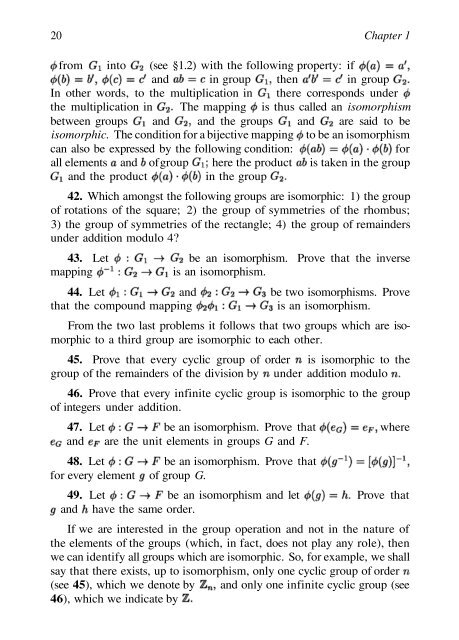Abel's theorem in problems and solutions - School of Mathematics
Abel's theorem in problems and solutions - School of Mathematics
Abel's theorem in problems and solutions - School of Mathematics
You also want an ePaper? Increase the reach of your titles
YUMPU automatically turns print PDFs into web optimized ePapers that Google loves.
20 Chapter 1<br />
from <strong>in</strong>to (see §1.2) with the follow<strong>in</strong>g property: if<br />
<strong>and</strong> <strong>in</strong> group then <strong>in</strong> group<br />
In other words, to the multiplication <strong>in</strong> there corresponds under<br />
the multiplication <strong>in</strong> The mapp<strong>in</strong>g is thus called an isomorphism<br />
between groups <strong>and</strong> <strong>and</strong> the groups <strong>and</strong> are said to be<br />
isomorphic. The condition for a bijective mapp<strong>in</strong>g to be an isomorphism<br />
can also be expressed by the follow<strong>in</strong>g condition: for<br />
all elements <strong>and</strong> <strong>of</strong> group here the product is taken <strong>in</strong> the group<br />
<strong>and</strong> the product <strong>in</strong> the group<br />
42. Which amongst the follow<strong>in</strong>g groups are isomorphic: 1) the group<br />
<strong>of</strong> rotations <strong>of</strong> the square; 2) the group <strong>of</strong> symmetries <strong>of</strong> the rhombus;<br />
3) the group <strong>of</strong> symmetries <strong>of</strong> the rectangle; 4) the group <strong>of</strong> rema<strong>in</strong>ders<br />
under addition modulo 4?<br />
43. Let be an isomorphism. Prove that the <strong>in</strong>verse<br />
mapp<strong>in</strong>g is an isomorphism.<br />
44. Let <strong>and</strong> be two isomorphisms. Prove<br />
that the compound mapp<strong>in</strong>g is an isomorphism.<br />
From the two last <strong>problems</strong> it follows that two groups which are isomorphic<br />
to a third group are isomorphic to each other.<br />
45. Prove that every cyclic group <strong>of</strong> order is isomorphic to the<br />
group <strong>of</strong> the rema<strong>in</strong>ders <strong>of</strong> the division by under addition modulo<br />
46. Prove that every <strong>in</strong>f<strong>in</strong>ite cyclic group is isomorphic to the group<br />
<strong>of</strong> <strong>in</strong>tegers under addition.<br />
47. Let be an isomorphism. Prove that where<br />
<strong>and</strong> are the unit elements <strong>in</strong> groups G <strong>and</strong> F.<br />
48. Let be an isomorphism. Prove that<br />
for every element <strong>of</strong> group G.<br />
49. Let be an isomorphism <strong>and</strong> let Prove that<br />
<strong>and</strong> have the same order.<br />
If we are <strong>in</strong>terested <strong>in</strong> the group operation <strong>and</strong> not <strong>in</strong> the nature <strong>of</strong><br />
the elements <strong>of</strong> the groups (which, <strong>in</strong> fact, does not play any role), then<br />
we can identify all groups which are isomorphic. So, for example, we shall<br />
say that there exists, up to isomorphism, only one cyclic group <strong>of</strong> order<br />
(see 45), which we denote by <strong>and</strong> only one <strong>in</strong>f<strong>in</strong>ite cyclic group (see<br />
46), which we <strong>in</strong>dicate by

















